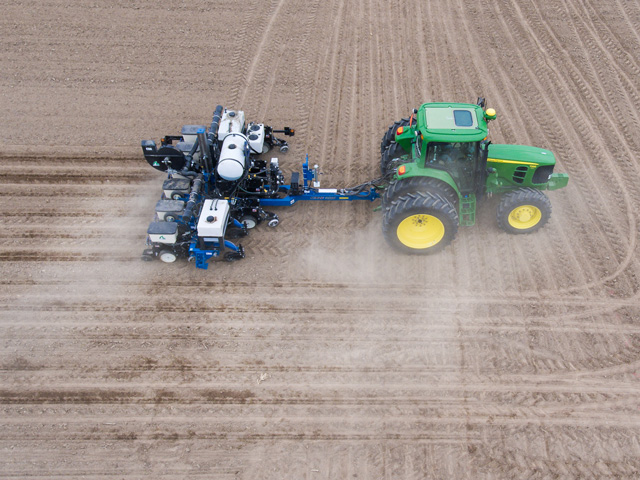Jump-Start Early Planted Soybeans
Strategically Placed Nutrients Help Early Planted Soybeans
ANKENY, Iowa (DTN) -- As crop input prices continue to soar, Mike Starkey intends to change his soybean fertility program to make every dollar count in 2022.
The Brownsburg, Indiana, farmer will likely forgo broadcast fertilizer applications unless soil tests show they're needed. Most nutrient costs have doubled or more in the last year, according to the DTN Fertilizer Index. Potash, for example, averaged $731 per ton the fourth week of October 2021 compared to $332 per ton a year earlier. Read more at https://www.dtnpf.com/….
High fertilizer costs, though, won't deter Starkey from applying a blend of potassium, phosphorus, nitrogen and micronutrients in-furrow while planting soybeans in the spring. All are essential, he believes, when planting soybeans early. The right amount of nutrients in the right place, among other things, help kick-start soybean germination and growth.
"You have to plant soybeans early with the right nutrients on well-drained ground to maximize yields," Starkey said. Treated seed is also a must, he added.
Starkey said he's had great success for more than 10 years applying three AgroLiquid products in-furrow when planting soybeans to promote early plant growth. These include Pro-Germinator (phosphate, nitrogen, potash and iron), Sure-K (nitrogen, phosphate, soluble potash) and Micro 500 (boron, zinc, manganese, iron and copper).
In 2022, Starkey is considering a change from Pro-Germinator to springuP, a more economical substitute from AgroLiquid for his phosphorus needs. SpringuP contains 4% nitrogen (N), 15% phosphate and 3% potash. In-furrow fertilizer products for soybeans contain little to no salt, making them safe to use.
Though application rates change based on need, Starkey will likely use 2 gallons of Sure-K, 1 gallon of springuP or Pro-Germinator and 1 quart of Micro 500 per acre at planting. He currently estimates the cost will be about $30 to $35 per acre with springuP or $35 to $45 per acre with Pro-Germinator. The cost at purchase will help determine which product is part of his in-furrow mix.
Starkey expects in-furrow starter fertilizers to pay for themselves. He typically gets a 5- to 8-bushel-per-acre yield bump when adding the nutrients.
"We're watching every dollar and make sure we get something back for the investment," said Starkey, who farms with his nephew, Jeff.
P[L1] D[0x0] M[300x250] OOP[F] ADUNIT[] T[]
PLANT EARLY
More and more soybean producers, such as Starkey, are putting fertilizer and crop-protection products in-furrow at planting, said Mike Staton, a Michigan State University (MSU) Extension soybean educator. This is partially in response to the growing trend of planting soybeans early -- before or at the same time as corn -- to boost yields.
The more time soybean plants have to absorb light spurs vegetative growth. That typically means more flowering, more nodes, more pods and more soybeans. A multistate study, "Benchmarking Soybean Production Systems in the North Central U.S.," indicates soybean yields decrease 0.2 to 0.5 bushels per acre per day when seed is planted after April 25. Read the study at https://coolbean.info/….
Planting early isn't without risk, though. Cool, wet soil can delay emergence and lengthen exposure of seeds to soil-borne pathogens. In-furrow nutrients and crop-protection products such as fungicides can spur early growth and improve plant health.
Staton said MSU researches in-furrow and near-seed fertilizer, and biological product placement. Results are mixed.
"Producers are always looking for ways to raise soybeans more intensively," he continued. "Farmers need to make sure the products and practices they're implementing allow them to maximize revenue potential.
"We've noticed some positive results with in-furrow fertilizer, but there are fewer winners than losers," Staton said.
The potential for a positive yield response from soybean starter fertilizer applied in-furrow or in a 2-by-2 band (fertilizer applied 2 inches below and 2 inches away from the seed) increases under certain conditions, according to MSU studies. These include when soil tests indicate phosphorus and potassium are below critical levels, and when cool or dry conditions occur after planting.
IN-FURROW TREND
Stephanie Zelinko, AgroLiquid sales agronomy manager, has noticed a trend of more farmers using in-furrow starter fertilizers for many crops, including soybeans. She said Pro-Germinator has a good return-on-investment track record, but that may not be the case for every treatment.
"We (and the customer) won't win every time ... we're very transparent about that," Zelinko said. "The likelihood is very high, but there are a lot of interactions we can't control with Mother Nature."
There are many in-furrow fertilizer and crop-protection products available for soybeans, such as Priaxor fungicide by BASF, Keylate CoMo Classic by Stoller and NACHURS playmaKer, among others.
**
The rising cost of fertilizer and supply issues will be a topic at the annual DTN Ag Summit in Chicago, Dec. 5-7. To check out the summit's agenda and to register, go to www.dtn.com/agsummit.
**
Editor's Note:
This article originally appeared on DTNPF.com on Nov. 18, 2020, as part of our Conquer Your Soybean Costs series. You can read the original version here: https://www.dtnpf.com/….
Matthew Wilde can be reached at matt.wilde@dtn.com
Follow him on Twitter @progressivwilde
(c) Copyright 2021 DTN, LLC. All rights reserved.






